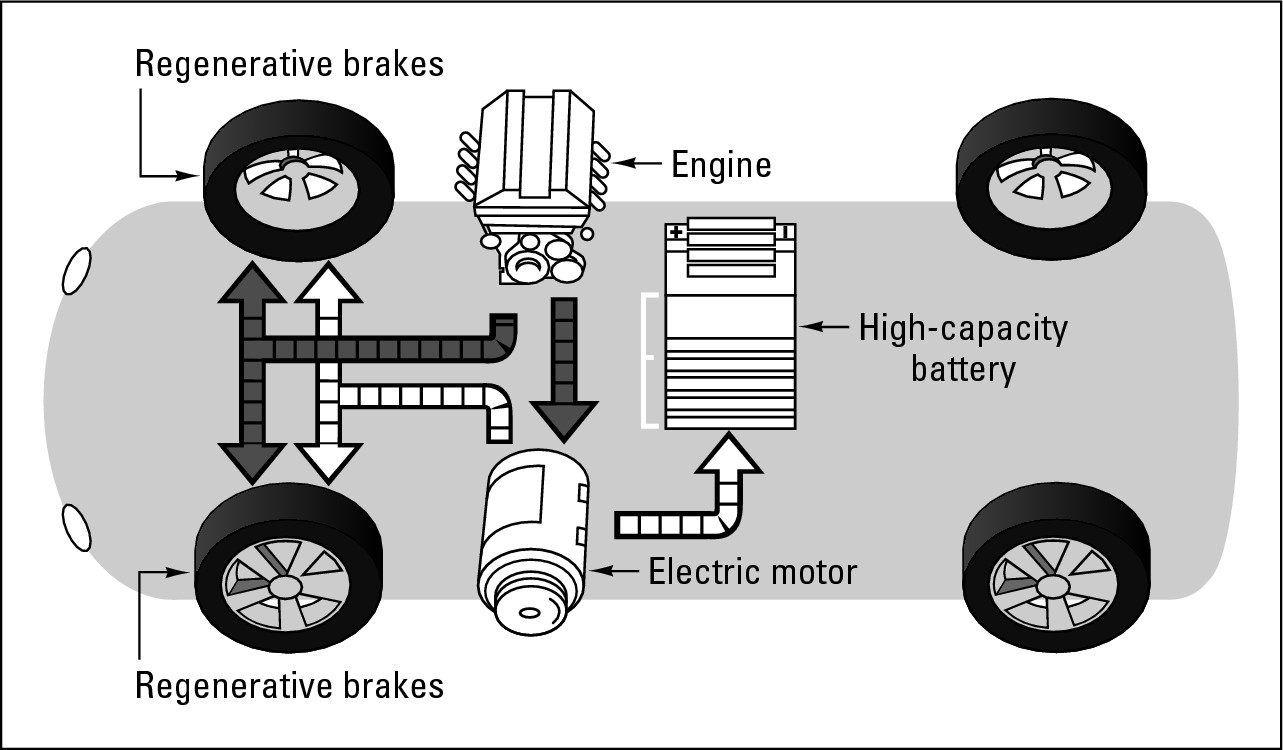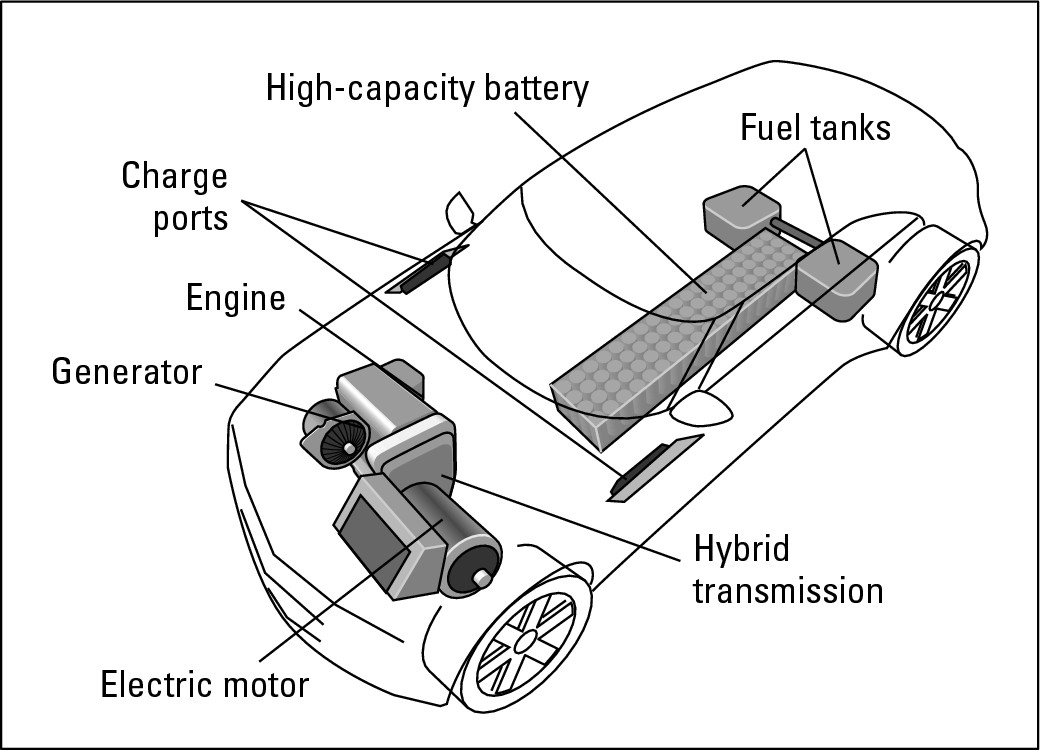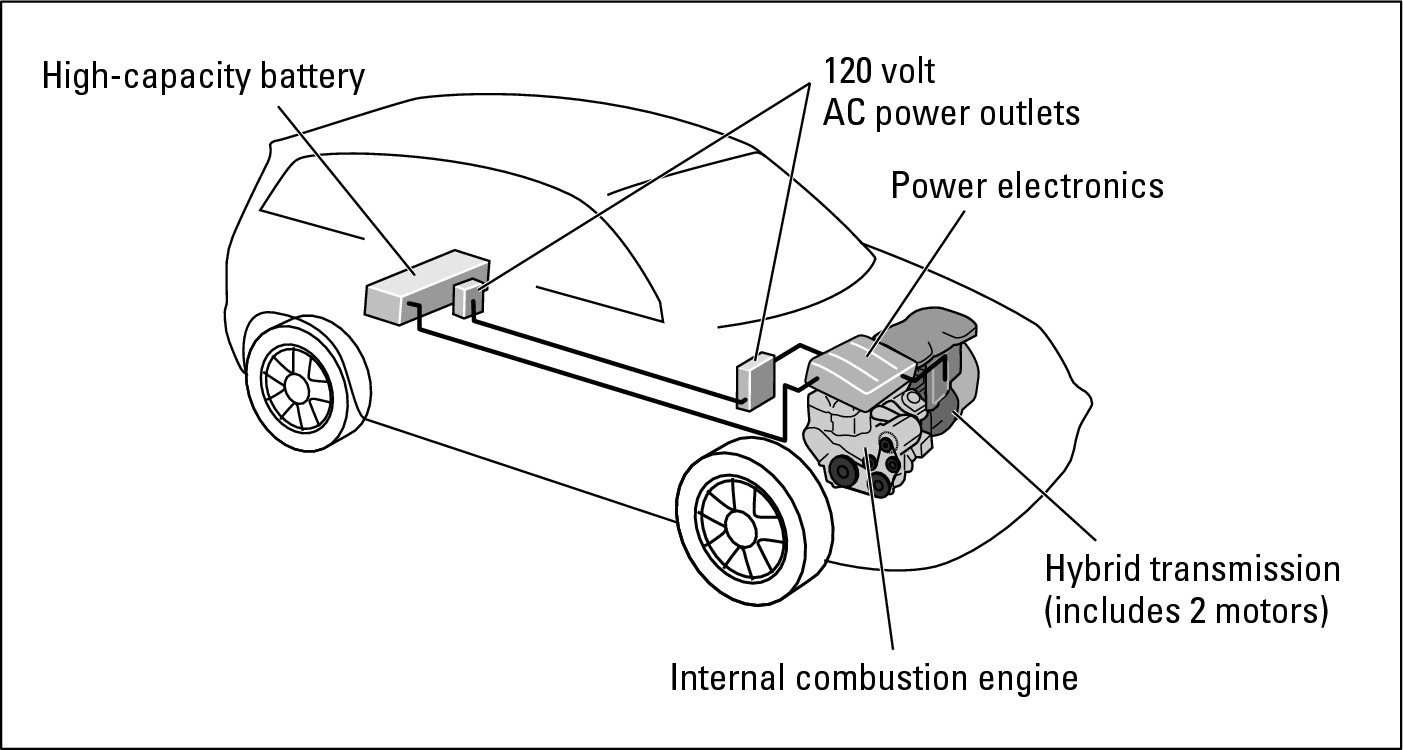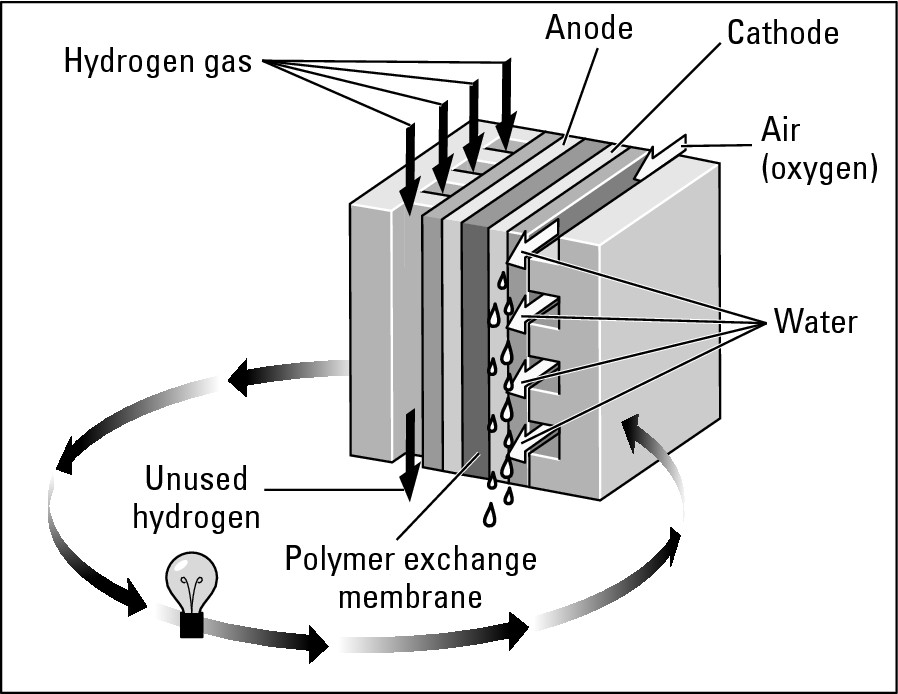Chapter 10
From Horses to Hybrids: Alternatively Powered Vehicles
In This Chapter
 Improving the internal combustion engine
Improving the internal combustion engine
 Checking out alternative fuels
Checking out alternative fuels
 Replacing fossil fuels with hybrids and electric vehicles
Replacing fossil fuels with hybrids and electric vehicles
 Moving ahead with hydrogen, fuel cells, and compressed natural gas
Moving ahead with hydrogen, fuel cells, and compressed natural gas
In recent years, environmental concerns about the impact of automotive exhaust on air quality, health, and global warming — plus the fact that the rapidly diminishing world supply of fossil fuels has contributed to international conflicts and radically raised the price of fossil fuels — have motivated hundreds of thousands of drivers to replace gas-guzzling vehicles with more efficient ones. United States federal and state clean-air laws, rising fuel-economy standards, and growing public and auto-industry awareness have greatly accelerated the development of an ever wider variety of vehicles that run on alternative fuels. Although alternatively fueled vehicles may require different kinds of fuel tanks, regenerative brakes, and modified fuel injection and emissions control systems, the brakes, cooling, steering, suspension, lubrication, and safety systems are pretty standard on most of them.
This chapter covers alternative fuels and vehicles that will eventually supplant traditional gasoline-powered internal combustion engines (ICE). However, it will be a while before ICEs are relegated to museums and classic car collections; improvements, particularly in emissions control systems, have made them cleaner and more efficient. The need for greater fuel efficiency has led to the development of ICEs that can shut down half their cylinders when power demand is light and then resume running on all cylinders when you need to “step on it.” Engineers also are constantly working on fine-tuning ICEs to boost fuel efficiency and reduce emissions and low rolling resistance tires have improved fuel economy as well.
.jpg)
Ethanol
Alcohol fuels have been around for years, typically mixed with gasoline in a blend also known as gasohol. E10, with a ratio of 10 percent gasoline to 90 percent ethanol, can be used in any ICE, and many oil companies already blend their fuels that way. Methanol, mostly used in race cars, isn’t popular for other vehicles because it isn’t as clean and it also relies on fossil fuels. The use of these fuels in higher proportions requires modification to the fuel storage and delivery systems on cars and trucks. E85, a mixture of 85 percent ethanol to 15 percent gasoline, can be used in flex-fuel vehicles, and car enthusiasts have modified their vehicles to run on ethanol or methanol alone, with mixed results. One point that’s commonly overlooked is that alcohol is about half as energy-dense as gasoline, so you can only go half as far on a tank.

The major controversy concerning ethanol fuel concerns the sources used to produce it. Corn-based ethanol has disastrous effects on the price and availability of corn for food and other products. It also doesn’t produce as much energy as gasoline and requires fossil-fuels to grow, refine, and deliver it. Happily, cellulosic ethanol does not have those drawbacks. Because it is derived from the cellulose found in non-food agricultural and waste products such as switch grass — a fast-growing plant that has a high yield of energy and requires little in the way of fertilization and other high-energy production costs — old newspapers, and other substances, it can compete with gasoline for fuel efficiency and not affect the price and supply of grains and other vegetation vital to humans and livestock.


How to find alternative fuels
Although production has dramatically increased, making these fuels available in thousands of service stations nationwide is a slow process. You can use the Internet to locate filling stations that sell alternative fuels in your area and on road trips. Check out these Web sites:
 www.eere.energy.gov/afdc/index.html: To find a fueling station in any city or zip code, look under Quick Links to AFDC Tools for the Alternative Fueling Station Locater.
www.eere.energy.gov/afdc/index.html: To find a fueling station in any city or zip code, look under Quick Links to AFDC Tools for the Alternative Fueling Station Locater.
 www.eere.energy.gov/afdc/fuels/stations_route_mapper.html: Enter the start and end points of a trip for route maps showing the location of alternative fuel stations.
www.eere.energy.gov/afdc/fuels/stations_route_mapper.html: Enter the start and end points of a trip for route maps showing the location of alternative fuel stations.
 gasprices.mapquest.com/index.jsp: This site helps you find stations selling a variety of alternative fuels in your area as well as the ones with the lowest price available.
gasprices.mapquest.com/index.jsp: This site helps you find stations selling a variety of alternative fuels in your area as well as the ones with the lowest price available.
Flex-fuel Vehicles
Vehicles that can run on two or more types of fuel are called flex-fuel vehicles (FFVs). (They’re also known as dual-fuel or multi-fuel vehicles.) The most popular FFVs can run on either gasoline or ethanol or a mixture of the two. At least one major carmaker has a test fleet of vehicles that burn liquid hydrogen but can switch to gasoline if there’s no hydrogen to be found. Many people drive FFVs and don’t even know it! If you’d like to know whether your vehicle is an FFV, check your owner’s manual, look for a sticker inside the little door you open to add fuel, call your dealership, or go to www.fueleconomy.gov, which has a list of available flex-fuel vehicles.
Hybrids
Hybrid vehicles are called hybrids because they utilize both a small internal combustion engine (ICE) and an electric motor to obtain maximum power and fuel economy with minimum emissions. How they do this varies from one model to another, with varying success. What all hybrids have in common is the ability to generate electric current, store it in a large battery, and use that current to help drive the car. This is usually done in two ways: Hybrids can capture electrical energy produced by a regenerative braking system (described later in this chapter), and their engines can power a generator, too. Hybrids can also conserve energy by shutting down the ICE when the vehicle is in Park, idling at a light, or stopped in traffic; or when the electric motor’s energy is sufficient to drive the vehicle without assistance from the ICE.
Parallel hybrids
A parallel hybrid (see Figure 10-1) uses both an electric motor and an internal combustion engine (ICE) for propulsion. They can run in tandem, or one can be used as the primary power source with the other kicking in to assist when extra power is needed for starting off, climbing hills, and accelerating to pass other vehicles. Because both are connected to the drive train, they’re said to run “in parallel.”
The Toyota Prius uses a power split device that connects the ICE, the electric motor and the continuously variable transmission (CVT) (see Chapter 18). It allows the engine and the motor to operate together or separately, and enables either one to generate power for storage or immediate use. It’s basically a parallel hybrid, but because of this unique feature, Toyota refers to it as a “series/parallel hybrid.”
I drive a Prius (named Esmerelda) so here’s as an example of how this type of parallel hybrid works:
1. When you press the ignition button, the electric motor uses energy stored in the high-voltage battery to start the car. (A 12-volt battery under the hood supplies power for lights, radio, and so on, as in conventional vehicles.)
2. Whenever the high-voltage battery needs charging, the ICE starts up to generate electricity for it, and once the vehicle is moving faster than around 15 mph, the ICE kicks in to provide additional power for accelerating, driving at high speeds, and going up hills.
3. When you step on the brakes, the regenerative braking system generates electricity to power the vehicle or be stored in the high-voltage battery.
4. When the vehicle stops, the ICE shuts off automatically so you don’t waste fuel. Even though you’re sitting there in a silent car, the radio, air conditioner, windshield wipers, and other electric features continue to work uninterrupted!
|
Figure 10-1: How a parallel hybrid works. |

|
Series hybrids
A series hybrid (see Figure 10-2) uses a gasoline or diesel ICE, coupled with a generator, to generate electricity but not to drive the car. The engine can send the electric current directly to the electric motor or charge a large battery that stores the electricity and delivers it to an electric motor on-demand. The electric motor propels the vehicle, using its power to rotate a driveshaft or a set of drive axles that turn the wheels.
|
Figure 10-2: A series hybrid. |

|
Plug-in hybrids
Because plug-in hybrids (see Figure 10-3) feature larger batteries that can be charged at any ordinary 110-volt electrical socket, they have the capacity to extend the ability of the electric motor to drive the car farther without the need for starting the ICE and therefore substantially increase the vehicle’s fuel efficiency. Estimates have ranged as high as 100 mpg!
Some technologically savvy individuals have adapted their hybrid vehicles into plug-in hybrids, and automakers are in the process of developing and producing them (sometimes in cooperation with major utility companies). The development of new, smaller, high-capacity lithium-ion batteries that can be recharged many times is the key to making plug-in hybrids available to the general public. Estimates are that plug-in hybrids equipped with these more powerful batteries will have a range of as much as 125 miles before the charge is depleted and the vehicle reverts to standard hybrid mode.
|
Figure 10-3: A plug-in hybrid. |

|

.jpg)
Two-mode hybrids
Two-mode hybrids (see Figure 10-4) may be the key to a competitive place for the U.S. in the hybrid market. Instead of the large storage battery found on conventional hybrids, two-mode hybrids use smaller batteries and two electric motors located inside an automatic transmission with two sets of gears — one for the ICE and the other to amplify the power of the electric motors. The transmission can function as a continuously variable transmission (CVT), as well. In one mode, at lower speeds, the vehicle can run with one or both electric motors, with or without the ICE, or on the ICE alone. At higher speeds, the second mode kicks in, and the ICE runs continuously in its higher gear ratios.
|
Figure 10-4: A two-mode hybrid. |

|
Regenerative brakes
Hybrids and other energy-efficient vehicles have regenerative braking systems that generate electric power to help keep the batteries charged. When the driver applies the brakes, the electric motor turns into a generator, and the magnetic drag slows the vehicle down. For safety, however, there is also a normal hydraulic braking system that can stop the car when regenerative braking isn’t sufficient. There’s no difference in maintenance or repair except that the brake pads tend to last much longer because they don’t get used as much. In fact, if you drive a hybrid in a moderate manner, you almost never actually use the disc brakes on the wheels and may be able to go the life of the car without changing pads. (Chapter 14 tells you about brakes.) The big difference is that regenerative brakes capture energy and turn it into electricity to charge the battery that provides power to an electric motor.
Electric Vehicles (EV)
Many people picture electric vehicles (EVs) as glorified golf carts powered by 12-volt batteries, with limited range and speed. They assume the vehicles are great for local driving but can’t contend with traffic on busy streets or highways. However, as larger and more powerful EVs with a wider range appear, this image is no longer accurate.
Modern EVs accelerate more powerfully, have competitive top speeds, seat at least five passengers, and can be recharged easily by their owners. They can haul big loads and climb steep hills with relative ease. As with plug-in hybrids, storage-battery technology has been slow to achieve the breakthrough needed to let EVs store enough energy to give them the extended range to compete with vehicles powered by conventional engines and to recharge fast enough to compete with just driving into a filling station. Major efforts are being made to improve storage batteries and cold-weather performance. EVs powered by fuel cells have the potential to overcome these drawbacks. EVs are already popular in Europe, and EVs with enhanced performance are featured in car shows throughout the U.S.
Electric vehicles utilize a powerful electric motor and a large capacity battery to store the energy and deliver it to the motor on-demand (see in Figure 10-5). They also have the same 12-volt battery as other vehicles to keep electric devices working when the motor that drives the vehicle isn’t in use. Otherwise, EVs have the same steering, suspension, and other gizmos as conventional vehicles and use the same regenerative braking system to generate electric current when the brakes are applied. Because EVs don’t have a conventional fuel system, a dashboard display tells you when the vehicle is generating, storing, or using electricity and how far you can go without recharging the battery.
Except for a small fan that may kick in for a short time when you start the car, EVs are silent when you start, drive, and come to a stop. How hard you step on the accelerator tells a computerized controller how fast you want to go. The controller can shut down the motor to prevent it from operating at too high a speed and deliver just the right amount of energy to the motor. The more power the motor receives, the faster it can turn the drive axle that transmits the power to the wheels. The power is transmitted to the drive axle directly because an electric motor delivers full torque at all times, so a transmission isn’t necessary. Despite this different configuration, you drive an EV in the same way as you do a conventional vehicle.

|
Figure 10-5: How an electric vehicle works. |

|
Tragic history of the EV
Although electric vehicles (EVs) were popular in the early 1900s, they were eclipsed by petroleum-powered cars. The first popular EV was the EV-1. General Motors produced and leased about 1,200 from 1997 to 1999. In 2004, when the last lease expired, although there was a waiting list of about 35,000, GM said that EVs weren’t popular enough to continue production. Over the protests of the lessees, who were willing to buy them, GM recalled the EV-1 and destroyed most of them. For undisclosed reasons, the Smithsonian even took their EV-1 off display a few years later! The documentary film Who Killed the Electric Car? delves into this controversial story. The demand for zero-emissions vehicles (ZEVs) has now renewed interest in a new generation (pardon the pun) of affordable electric vehicles.
Hydrogen and Fuel Cell Vehicles
Although hydrogen is the element found in the greatest quantities in the universe, it doesn’t exist in a purely natural state on earth as fossil fuels do. It is attractive as a fuel because, by a process called electrolysis, it can theoretically be derived from water, the air, and many other substances. Of course, until ways can be found to fill a vehicle’s tank with water and have it produce its own hydrogen, there’s still the problem of the fossil-fuel energy necessary to produce hydrogen in large quantities and deliver it to a vehicle as a liquid or gas. And because hydrogen is highly flammable and very cold in its liquid form (minus 453°F!), there are safety concerns about shipping it, pumping it into a vehicle’s fuel tank, and storing it there under extreme pressure.
How fuel cells work
A fuel cell creates electrical current from hydrogen and oxygen and may well be the best use of hydrogen as an alternative to fossil-fueled vehicles. When used in a hydrogen-powered EV called a fuel cell vehicle (FCV), virtually the only tailpipe emissions that hydrogen produces are water molecules. Although there are many types of fuel cells, the ones using a polymer exchange membrane are the most popular for vehicles because they produce more power and operate at lower temperatures, which enables them to warm up faster than other, hotter, types of fuel cells. The resulting current is fed directly to the vehicle’s electric motor.
As you can see in Figure 10-6, a fuel cell has a positive anode and a negative cathode. Hydrogen gas enters the cell and is sent to the anode, while oxygen in the form of air flows to the cathode. A thin plate of platinum particles serves as a catalyst to split each atom of hydrogen into positive and negative ions. The polymer electrolyte membrane lets the positive ions go through it to the anode. The negative ions can’t get through and have to take another route to the cathode — on the way they create electrical current to drive the electric motor of the vehicle (represented as a light bulb in Figure 10-6).
When the positive and negative hydrogen ions are reunited at the cathode, they combine with the oxygen from the air into H2O and leave the cell as water vapor. On vehicles, hundreds of individual fuel cells are linked together into fuel cell stacks to increase the electrical output. Whether or not they become widely available depends on whether cheaper and more efficient alternative vehicles eliminate the need for them.
|
Figure 10-6: How a fuel cell works. |

|
Adapted from the Department of Energy (www.fueleconomy.gov)
Natural Gas Vehicles (NGV)
Natural gas vehicles (NGV) use compressed natural gas (CNG) rather than liquid natural gas (LNG) such as butane and propane. Because CNG burns cleanly with few emissions, NGVs are popular outside the United States. NGVs haven’t been as popular in the U.S. because natural gas isn’t as available as gasoline at filling stations, although it is a common fuel for shuttles, buses, and fleets that must meet government clean-air requirements.


|
Figure 10-7: A natural gas vehicle. |

|
